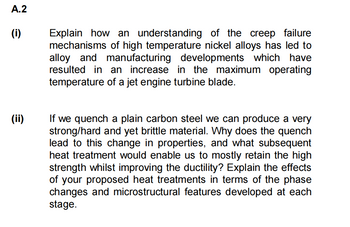
Elements Of Electromagnetics
7th Edition
ISBN: 9780190698614
Author: Sadiku, Matthew N. O.
Publisher: Oxford University Press
expand_more
expand_more
format_list_bulleted
Question

Transcribed Image Text:A.2
(i)
(ii)
Explain how an understanding of the creep failure
mechanisms of high temperature nickel alloys has led to
alloy and manufacturing developments which have
resulted in an increase in the maximum operating
temperature of a jet engine turbine blade.
If we quench a plain carbon steel we can produce a very
strong/hard and yet brittle material. Why does the quench
lead to this change in properties, and what subsequent
heat treatment would enable us to mostly retain the high
strength whilst improving the ductility? Explain the effects
of your proposed heat treatments in terms of the phase
changes and microstructural features developed at each
stage.
Expert Solution
This question has been solved!
Explore an expertly crafted, step-by-step solution for a thorough understanding of key concepts.
Step by stepSolved in 6 steps

Knowledge Booster
Learn more about
Need a deep-dive on the concept behind this application? Look no further. Learn more about this topic, mechanical-engineering and related others by exploring similar questions and additional content below.Similar questions
- What are some possible defects in drawn sheet-metal parts? In blanking of a circular sheet-metal part, is the clearance applied to the punch diameter or the die diameter? What is martensite? Based on the TTT curve, what is it that should be avoided during martensitic process? What is the main condition for strengthening an alloy by precipitation?arrow_forwardDefine quenching. (a) What effects does it have on the microstructure? (b) How does this affect dislocation movement? (c) Why/how does this affect the properties?arrow_forward3.The TTT diagram of a plain carbon steel is given in Fig. 1. Identify whether this steel is a hypoeutectoid, eutectoid or hypereutectoid steel. Explain why the transformation happens slowly at 850°C as well as at 300°C. Determine the microstructures expected in this type of steel after the following heat treatment processes. a) Austenize at 900°C, quench to 400°C and hold for 1000 s and quench to 25°C. b) Austenize at 900°C, quench to 25°C. c) Austenize at 900°C, quench to 675°C and hold for 1 s, quench to 400°C and hold for 900 s and slowly cool to 25°C. 900 Acm Cs 800 A1 FezC + Y 33 Fe3C + pearlite 45 700 Ps 600 ++ Fe3C + pearlite Y+ bainite Bs 500 46 Bainite 400 Yu Bf 300 57 Ms 200 60 Mf Y+ martensite 100 62 Martensite 102 65 103 104 105 106 0.1 1 10 Time (s) Fig. 1 Temperature (°C) Rockwell C hardnessarrow_forward
- Look up the standard aluminum alloy heat treatment temper designations. Use the designations to justify the yield strength behavior of the following aluminum alloys listed in Table 1.2: 2024-T3 vs. 2024-T6 and 7075-T6 vs. 7075-T73.arrow_forwardAustentitic stainless steel's are not hardenable by cold working however Austentic stainless steel's can be strengthened by heat treatment true or false?arrow_forwardQUESTION 4 A method of determining the result of heat treatment as well as the state of a metal prior to heat treatment TTTArial 3 (12pt) Path: p !!!arrow_forward
- Nickel-based alloys are used for gas turbine blades in aerospace engines. Briefly discuss the characteristics that make these alloys the choice for this application. Single-crystal technology is applied to nickel alloys that are used as gas turbine blades in aerospace engines. With the aid of sketches describe how a single-crystal casting can be manufactured and explain why a single-crystal casting is likely to have superior creep resistance than a directly-solidified one. Demonstrate the application of the Ten-percent Rule by calculating the approximate tensile strength and elastic modulus in the 0° direction of a carbon-fibre reinforced polymer composite if the strength and elastic moduluş in the 0° single ply are 3620 MPa and 143 GPa respectively. The lay-up sequence of the composite is [02/+45/-45/902]s.arrow_forwarda) Explain why work hardenable aluminium alloys cannot be age-hardened because the precipitation hardening reaction does not occur. To maintain strength, what might be another reason why aluminium alloys can't be work hardened? (Think about dislocations.)arrow_forwardWhat does the process of temper drying do for hardened carbon steel?arrow_forward
arrow_back_ios
arrow_forward_ios
Recommended textbooks for you
 Elements Of ElectromagneticsMechanical EngineeringISBN:9780190698614Author:Sadiku, Matthew N. O.Publisher:Oxford University Press
Elements Of ElectromagneticsMechanical EngineeringISBN:9780190698614Author:Sadiku, Matthew N. O.Publisher:Oxford University Press Mechanics of Materials (10th Edition)Mechanical EngineeringISBN:9780134319650Author:Russell C. HibbelerPublisher:PEARSON
Mechanics of Materials (10th Edition)Mechanical EngineeringISBN:9780134319650Author:Russell C. HibbelerPublisher:PEARSON Thermodynamics: An Engineering ApproachMechanical EngineeringISBN:9781259822674Author:Yunus A. Cengel Dr., Michael A. BolesPublisher:McGraw-Hill Education
Thermodynamics: An Engineering ApproachMechanical EngineeringISBN:9781259822674Author:Yunus A. Cengel Dr., Michael A. BolesPublisher:McGraw-Hill Education Control Systems EngineeringMechanical EngineeringISBN:9781118170519Author:Norman S. NisePublisher:WILEY
Control Systems EngineeringMechanical EngineeringISBN:9781118170519Author:Norman S. NisePublisher:WILEY Mechanics of Materials (MindTap Course List)Mechanical EngineeringISBN:9781337093347Author:Barry J. Goodno, James M. GerePublisher:Cengage Learning
Mechanics of Materials (MindTap Course List)Mechanical EngineeringISBN:9781337093347Author:Barry J. Goodno, James M. GerePublisher:Cengage Learning Engineering Mechanics: StaticsMechanical EngineeringISBN:9781118807330Author:James L. Meriam, L. G. Kraige, J. N. BoltonPublisher:WILEY
Engineering Mechanics: StaticsMechanical EngineeringISBN:9781118807330Author:James L. Meriam, L. G. Kraige, J. N. BoltonPublisher:WILEY

Elements Of Electromagnetics
Mechanical Engineering
ISBN:9780190698614
Author:Sadiku, Matthew N. O.
Publisher:Oxford University Press

Mechanics of Materials (10th Edition)
Mechanical Engineering
ISBN:9780134319650
Author:Russell C. Hibbeler
Publisher:PEARSON

Thermodynamics: An Engineering Approach
Mechanical Engineering
ISBN:9781259822674
Author:Yunus A. Cengel Dr., Michael A. Boles
Publisher:McGraw-Hill Education

Control Systems Engineering
Mechanical Engineering
ISBN:9781118170519
Author:Norman S. Nise
Publisher:WILEY

Mechanics of Materials (MindTap Course List)
Mechanical Engineering
ISBN:9781337093347
Author:Barry J. Goodno, James M. Gere
Publisher:Cengage Learning

Engineering Mechanics: Statics
Mechanical Engineering
ISBN:9781118807330
Author:James L. Meriam, L. G. Kraige, J. N. Bolton
Publisher:WILEY